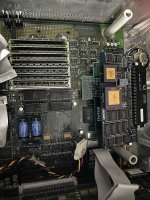thisisamigaspeaking
Veteran Member
I'm having trouble finding much information on Mac II repair on youtube. This machine isn't chiming right now. I've replaced the two 1/2 AA batteries. There was no leakage of the batteries or obvious leaky caps. The machine is extremely clean inside. There was a RasterOps 224 video card, an Apple video card with 13w3 connector which I believe is a Portrait card, and a 10 Mbit ethernet card. It doesn't chime with all the cards removed either. Is my next step to get a 16 MHz 020 and see if it's the DayStar board? Thanks.


